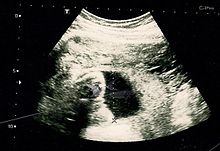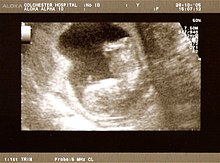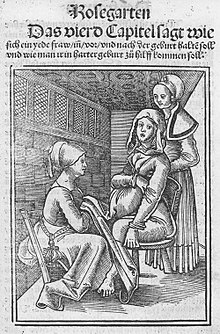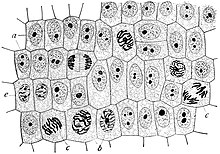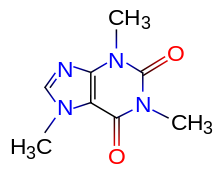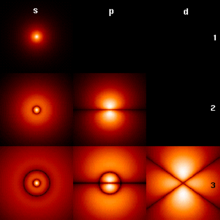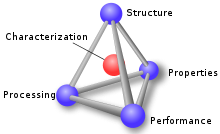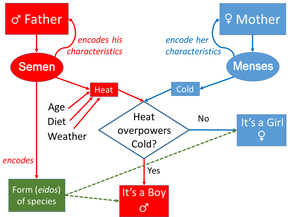Obstetrics is the field of study concentrated on pregnancy, childbirth, and the postpartum period. As a medical specialty, obstetrics is combined with gynaecology under the discipline known as obstetrics and gynecology (OB/GYN), which is a surgical field.
Main areas
Prenatal care
Prenatal care is important in screening for various complications of pregnancy. This includes routine office visits with physical exams and routine lab tests:
First trimester
- Complete blood count (CBC)
- Blood type
- General antibody screen (indirect Coombs test) for HDN
- Rh D negative antenatal patients should receive RhoGam at 28 weeks to prevent Rh disease.
- Rapid plasma reagin (RPR) to screen for syphilis
- Rubella antibody screen
- Hepatitis B surface antigen
- Gonorrhea and Chlamydia culture
- PPD for tuberculosis
- Pap smear
- Urinalysis and culture
- HIV screen
Genetic screening for Down syndrome (trisomy 21) and trisomy 18, the
national standard in the United States, is rapidly evolving away from
the AFP-Quad screen for Down syndrome, done typically in the second
trimester at 16–18 weeks. The newer integrated screen (formerly called
F.A.S.T.E.R for First And Second Trimester Early Results) can be done at
10 plus weeks to 13 plus weeks with an ultrasound of the fetal neck
(thicker nuchal skin correlates with higher risk of Down syndrome being
present) and two chemicals (analytes) PAPP-A and βHCG
(pregnancy hormone level itself). It gives an accurate risk profile
very early. A second blood screen at 15 to 20 weeks refines the risk
more accurately. The cost is higher than an "AFP-quad" screen due to the
ultrasound and second blood test, but it is quoted to have a 93% pick
up rate as opposed to 88% for the standard AFP/QS. This is an evolving
standard of care in the United States.
Second trimester
- MSAFP/quad. screen (four simultaneous blood tests) (maternal serum AFP, inhibin A, estriol, & βHCG) – elevations, low numbers or odd patterns correlate with neural tube defect risk and increased risks of trisomy 18 or trisomy 21
- Ultrasound either abdominal or transvaginal to assess cervix, placenta, fluid and baby
- Amniocentesis is the national standard (in what country) for women over 35 or who reach 35 by mid pregnancy or who are at increased risk by family history or prior birth history.
Third trimester
- Hematocrit (if low, the mother receives iron supplements)
- Group B Streptococcus screen. If positive, the woman receives IV penicillin or ampicillin while in labor—or, if she is allergic to penicillin, an alternative therapy, such as IV clindamycin or IV vancomycin.
- Glucose loading test (GLT) – screens for gestational diabetes; if > 140 mg/dL, a glucose tolerance test (GTT) is administered; a fasting glucose > 105 mg/dL suggests gestational diabetes.
Most doctors do a sugar load in a drink form of 50 grams of glucose
in cola, lime or orange and draw blood an hour later (plus or minus 5
minutes). The standard modified criteria have been lowered to 135 since
the late 1980s.
The result of an Ultrasonography: a black and white image that shows a clear view of the interior abdomen.
Fetal assessments
A dating scan at 12 weeks.
Obstetric ultrasonography
is routinely used for dating the gestational age of a pregnancy from
the size of the fetus, determine the number of fetuses and placentae, evaluate for an ectopic pregnancy
and first trimester bleeding, the most accurate dating being in first
trimester before the growth of the foetus has been significantly
influenced by other factors. Ultrasound is also used for detecting
congenital anomalies (or other foetal anomalies) and determining the biophysical profiles
(BPP), which are generally easier to detect in the second trimester
when the foetal structures are larger and more developed. Specialised
ultrasound equipment can also evaluate the blood flow velocity in the umbilical cord, looking to detect a decrease/absence/reversal or diastolic blood flow in the umbilical artery.
X-rays and computerized tomography (CT) are not used, especially in the first trimester, due to the ionizing radiation, which has teratogenic effects on the foetus. No effects of magnetic resonance imaging (MRI) on the foetus have been demonstrated, but this technique is too expensive for routine observation. Instead, obstetric ultrasonography is the imaging method of choice in the first trimester and throughout the pregnancy, because it emits no radiation, is portable, and allows for realtime imaging.
The safety of frequent ultrasound scanning has not be confirmed.
Despite this, increasing numbers of women are choosing to have
additional scans for no medical purpose, such as gender scans, 3D and 4D
scans. A normal gestation would reveal a gestational sac, yolk sac, and fetal pole. The gestational age can be assessed by evaluating the mean gestational sac diameter (MGD) before week 6, and the crown-rump length after week 6. Multiple gestation is evaluated by the number of placentae and amniotic sacs present.
Other tools used for assessment include:
- Fetal screening is used to help assess the viability of the fetus, as well as congenital abnormalities.
- Fetal karyotype can be used for the screening of genetic diseases. This can be obtained via amniocentesis or chorionic villus sampling (CVS)
- Foetal haematocrit for the assessment of foetal anemia, Rh isoimmunization, or hydrops can be determined by percutaneous umbilical blood sampling (PUBS), which is done by placing a needle through the abdomen into the uterus and taking a portion of the umbilical cord.
- Fetal lung maturity is associated with how much surfactant the fetus is producing. Reduced production of surfactant indicates decreased lung maturity and is a high risk factor for infant respiratory distress syndrome. Typically a lecithin:sphingomyelin ratio greater than 1.5 is associated with increased lung maturity.
- Nonstress test (NST) for fetal heart rate
- Oxytocin challenge test
Intercurrent diseases
A pregnant woman may have intercurrent diseases,
that is, other diseases or conditions (not directly caused by the
pregnancy) that may become worse or be a potential risk to the
pregnancy.
- Diabetes mellitus and pregnancy deals with the interactions of diabetes mellitus (not restricted to gestational diabetes) and pregnancy. Risks for the child include miscarriage, growth restriction, growth acceleration, foetal obesity (macrosomia), polyhydramnios and birth defects.
- Systemic lupus erythematosus and pregnancy confers an increased rate of foetal death in utero and spontaneous abortion (miscarriage), as well as of neonatal lupus.
- Thyroid disease in pregnancy can, if uncorrected, cause adverse effects on foetal and maternal well-being. The deleterious effects of thyroid dysfunction can also extend beyond pregnancy and delivery to affect neurointellectual development in the early life of the child. Demand for thyroid hormones is increased during pregnancy, and may cause a previously unnoticed thyroid disorder to worsen.
- Hypercoagulability in pregnancy is the propensity of pregnant women to develop thrombosis (blood clots). Pregnancy itself is a factor of hypercoagulability (pregnancy-induced hypercoagulability), as a physiologically adaptive mechanism to prevent post partum bleeding. However, when combined with an additional underlying hypercoagulable states, the risk of thrombosis or embolism may become substantial.
Induction and labour
Induction is a method of artificially or prematurely stimulating labour in a woman. Reasons to induce can include pre-eclampsia,
foetal distress, placental malfunction, intrauterine growth retardation
and failure to progress through labour increasing the risk of infection
and foetal distresses.
Induction may be achieved via several methods:
- Disturbance of cervical memebranes
- Pessary of Prostin cream, prostaglandin E2
- Intravaginal or oral administration of misoprostol
- Cervical insertion of a 30-mL Foley catheter
- Rupturing the amniotic membranes
- Intravenous infusion of synthetic oxytocin (Pitocin or Syntocinon)
During labour, the obstetrician carries out the following tasks:
- Monitor the progress of labour, by reviewing the nursing chart, performing vaginal examination, and assessing the trace produced by a foetal monitoring device (the cardiotocograph)
- Provide pain relief, either by nitrous oxide, opiates, or by epidural anaesthesia done by anaesthestists, an anaesthesiologist, or a nurse anaesthetist.
- Caesarean section, if there is an associated risk with vaginal delivery, as such foetal or maternal compromise.
Complications and emergencies
The main emergencies include:
- Ectopic pregnancy is when an embryo implants in the uterine (Fallopian) tube or (rarely) on the ovary or inside the peritoneal cavity. This may cause massive internal bleeding.
- Pre-eclampsia is a disease defined by a combination of signs and symptoms that are related to maternal hypertension. The cause is unknown, and markers are being sought to predict its development from the earliest stages of pregnancy. Some unknown factors cause vascular damage in the endothelium, causing hypertension. If severe, it progresses to eclampsia, where seizures occur, which can be fatal. Preeclamptic patients with the HELLP syndrome show liver failure and Disseminated intravascular coagulation (DIC). The only treatment is to deliver the foetus. Women may still develop pre-eclampsia following delivery.
- Placental abruption is where the placenta detaches from the uterus and the woman and foetus can bleed to death if not managed appropriately.
- Foetal distress where the foetus is getting compromised in the uterine environment.
- Shoulder dystocia where one of the foetus' shoulders becomes stuck during vaginal birth. There are many risk factors, including macrosmic (large) foetus, but many are also unexplained.
- Uterine rupture can occur during obstructed labour and endanger foetal and maternal life.
- Prolapsed cord can only happen after the membranes have ruptured. The umbilical cord delivers before the presenting part of the foetus. If the foetus is not delivered within minutes, or the pressure taken off the cord, the foetus dies.
- Obstetrical hemorrhage may be due to a number of factors such as placenta previa, uterine rupture or tears, uterine atony, retained placenta or placental fragments, or bleeding disorders.
- Puerperal sepsis is an ascending infection of the genital tract. It may happen during or after labour. Signs to look out for include signs of infection (pyrexia or hypothermia, raised heart rate and respiratory rate, reduced blood pressure), and abdominal pain, offensive lochia (blood loss) increased lochia, clots, diarrhea and vomiting.
Postnatal care
Postnatal care is care provided to the mother following parturition.
A woman in the Western world who is delivering in a hospital
may leave the hospital as soon as she is medically stable and chooses
to leave, which can be as early as a few hours postpartum, though the
average for spontaneous vaginal delivery (SVD) is 1–2 days, and the average caesarean section postnatal stay is 3–4 days.
During this time the mother is monitored for bleeding, bowel and bladder function, and baby care. The infant's health is also monitored.
Certain things must be kept in mind as the physician proceeds with the post-natal care.
- General condition of the patient.
- Check for vital signs (pulse, blood pressure, temperature, respiratory rate, (pain) at times)
- Palour?
- Oedema?
- Dehydration?
- Fundus (height following parturition, and the feel of the fundus) (Per abdominal examination)
- If an episiotomy or a C-section was performed, check for the dressing. Intact, pus, oozing, haematomas?
- Lochia (colour, amount, odour)?
- Bladder (keep the patient catheterized for 12 hours following local anaesthesia and 24–48 hours after general anaesthesia) ? (check for bladder function)
- Bowel movements?
- More bowel movements?
- Follow up with the neonate to check if they are healthy.
Veterinary obstetrics
History
Two midwives assisting a woman in labour on a birthing chair in the 16th century, from a work by Eucharius Rößlin.
Prior to the 18th century, caring for pregnant women in Europe was confined exclusively to women,
and rigorously excluded men. The expectant mother would invite close
female friends and family members to her home to keep her company during
childbirth. Skilled midwives
managed all aspects of the labour and delivery. The presence of
physicians and surgeons was very rare and only occurred if a serious
complication had taken place and the midwife had exhausted all measures
at her disposal. Calling a surgeon was very much a last resort and
having men deliver women in this era was seen as offending female
modesty.
Before the 18th century
Prior to the 18th and 19th centuries, midwifery
was well established but obstetrics was not recognized as a specific
medical specialty. However, the subject matter and interest in the female reproductive system and sexual practice can be traced back to Ancient Egypt and Ancient Greece. Soranus of Ephesus
sometimes is called the most important figure in ancient gynecology.
Living in the late first century A.D. and early second century, he
studied anatomy and had opinions and techniques on abortion,
contraception –most notably coitus interruptus–
and birth complications. After his death, techniques and works of
gynecology declined; very little of his works were recorded and survived
to the late 18th century when gynecology and obstetrics reemerged as a
medical specialism.
18th century
The 18th century marked the beginning of many advances in European midwifery,
based on better knowledge of the physiology of pregnancy and labour. By
the end of the century, medical professionals began to understand the
anatomy of the uterus and the physiological changes that take place
during labour. The introduction of forceps in childbirth
also took place at this time. All these medical advances in obstetrics
were a lever for the introduction of men into an arena previously
managed and run by women—midwifery.
The addition of the male-midwife (or man-midwife) is historically
a significant change to the profession of obstetrics. In the 18th
century medical men began to train in area of childbirth and believed
with their advanced knowledge in anatomy that childbirth could be
improved. In France these male-midwives were referred to as accoucheurs, a title later used all over Europe. The founding of lying-in hospitals also contributed to the medicalization and male-dominance of obstetrics. These early maternity hospitals
were establishments where women would come to have their babies
delivered, as opposed to the practice since time immemorial of the
midwife attending the home of the woman in labour. This institution
provided male-midwives with endless patients to practice their
techniques on and was a way for these men to demonstrate their
knowledge.
Many midwives of the time bitterly opposed the involvement of men
in childbirth. Some male practitioners also opposed the involvement of
medical men like themselves in midwifery and even went as far as to say
that male-midwives only undertook midwifery solely for perverse erotic
satisfaction. The accoucheurs argued that their involvement in midwifery
was to improve the process of childbirth. These men also believed that
obstetrics would forge ahead and continue to strengthen.
19th century
18th
century physicians expected that obstetrics would continue to grow, but
the opposite happened. Obstetrics entered a stage of stagnation in the
19th century, which lasted until about the 1880s.
The central explanation for the lack of advancement during this time
was the rejection of obstetrics by the medical community. The 19th
century marked an era of medical reform in Europe and increased
regulation over the profession. Major European institutions such as The
College of Physicians and Surgeons considered delivering babies ungentlemanly work and refused to have anything to do with childbirth as a whole. Even when Medical Act 1858 was introduced, which stated that medical students could qualify as doctors, midwifery
was entirely ignored. This made it nearly impossible to pursue an
education in midwifery and also have the recognition of being a doctor
or surgeon. Obstetrics was pushed to the side.
By the late 19th century, the foundation of modern-day obstetrics
and midwifery began developing. Delivery of babies by doctors became
popular and readily accepted, but midwives continued to play a role in
childbirth. Midwifery also changed during this era due to increased
regulation and the eventual need for midwives to become certified. Many
European countries by the late 19th century were monitoring the training
of midwives and issued certification based on competency. Midwives were
no longer uneducated in the formal sense.
As midwifery began to develop, so did the profession of
obstetrics near the end of the century. Childbirth was no longer
unjustifiably despised by the medical community as it once had been at
the beginning of the century. But obstetrics was underdeveloped compared
to other medical specialites. Many male physicians would deliver
children but very few would have referred to themselves as
obstetricians. The end of the 19th century did mark a significant
accomplishment in the profession with the advancements in asepsis and anaesthesia, which paved the way for the mainstream introduction and later success of the Caesarean Section.
Before the 1880s mortality rates in lying-hospitals would reach
unacceptably high levels and became an area of public concern. Much of
these maternal deaths were due to puerperal fever, then known as childbed fever. In the 1800s Dr. Ignaz Semmelweis
noticed that women giving birth at home had a much lower incidence of
childbed fever than those giving birth by physicians in lying-hospitals.
His investigation discovered that washing hands with an antiseptic solution before a delivery reduced childbed fever fatalities by 90%.
So it was concluded that it was physicians who had been spreading
disease from one labouring mother to the next. Despite the publication
of this information, doctors still would not wash. It was not until the
20th century when advancements in aseptic technique and the
understanding of disease would play a significant role in the decrease
of maternal mortality rates among many populations.
History of obstetrics in America
The
development of obstetrics as a practice for accredited doctors happened
at the turn of the 18th century and thus was very differently developed
in Europe and in the Americas due to the independence of many countries
in the Americas from European powers. “Unlike in Europe and the British
Isles, where midwifery laws were national, in America, midwifery laws were local and varied widely”.
Gynaecology and Obstetrics gained attention in the American
medical field at the end of the nineteenth century through the
development of such procedures as the ovariotomy. These procedures then
were shared with European surgeons who replicated the surgeries. This
was a period when antiseptic, aseptic or anaesthetic measures were just
being introduced to surgical and observational procedures and without
these procedures surgeries were dangerous and often fatal. Following are
two surgeons noted for their contributions to these fields include Ephraim McDowell and James Marion Sims.
Ephraim McDowell developed a surgical practice in 1795 and
performed the first ovariotomy in 1809 on a 47-year-old widow who then
lived on for thirty-one more years. He had attempted to share this with
John Bell whom he had practiced under who had retired to Italy. Bell was
said to have died without seeing the document but it was published by
an associate in Extractions of Diseased Ovaria in 1825. By the
mid-century the surgery was both successfully and unsuccessfully being
performed. Pennsylvanian surgeons the Attlee brothers made this
procedure very routine for a total of 465 surgeries–John Attlee
performed 64 successfully of 78 while his brother William reported 387–
between the years of 1843 and 1883. By the middle of the nineteenth
century this procedure was successfully performed in Europe by English
surgeons Sir Spencer Wells and Charles Clay as well as French surgeons Eugène Koeberlé, Auguste Nélaton and Jules Péan.
J. Marion Sims was the surgeon responsible for being the first treating a vesicovaginal fistula – a
condition linked to many caused mainly by prolonged pressing of the
feotus against the pelvis or other causes such as rape, hysterectomy, or
other operations– and also having been doctor to many European royals
and the 20th President of the United States James A. Garfield after he
had been shot. Sims does have a controversial medical past. Under the
beliefs at the time about pain and the prejudice towards African people,
he had practiced his surgical skills and developed skills on slaves. These women were the first patients of modern gynecology. One of the women he operated on was named Anarcha Westcott, the woman he first treated for a fistula.
Historical role of gender
Women
and men inhabited very different roles in natal care up to the 18th
century. The role of a physician was exclusively held by men who went to
university, an overly male institution, who would theorize anatomy and
the process of reproduction based on theological teaching and
philosophy. Many beliefs about the female body and menstruation in the
17th and 18th centuries were inaccurate; clearly resulting from the lack
of literature about the practice. Many of the theories of what caused menstruation prevailed from Hippocratic philosophy. Midwives
of this time were those assisted in the birth and care of both born and
unborn children, and as the name suggests, this position was held
mainly by women.
During the birth of a child, men were rarely present. Women from
the neighbourhood or family would join in on the process of birth and
assist in many different ways. The one position where men would help
with the birth of a child would be in the sitting position, usually when
performed on the side of a bed to support the mother.
Men were introduced into the field of obstetrics in the
nineteenth century and resulted in a change of the focus of this
profession. Gynaecology directly resulted as a new and separate field of
study from obstetrics and focused on the curing of illness and
indispositions of female sexual organs. This had some relevance to some
conditions as menopause, uterine and cervical problems, and childbirth
could leave the mother in need of extensive surgery to repair tissue.
But, there was also a large blame of the uterus for completely unrelated
conditions. This led to many social consequences of the nineteenth
century.



